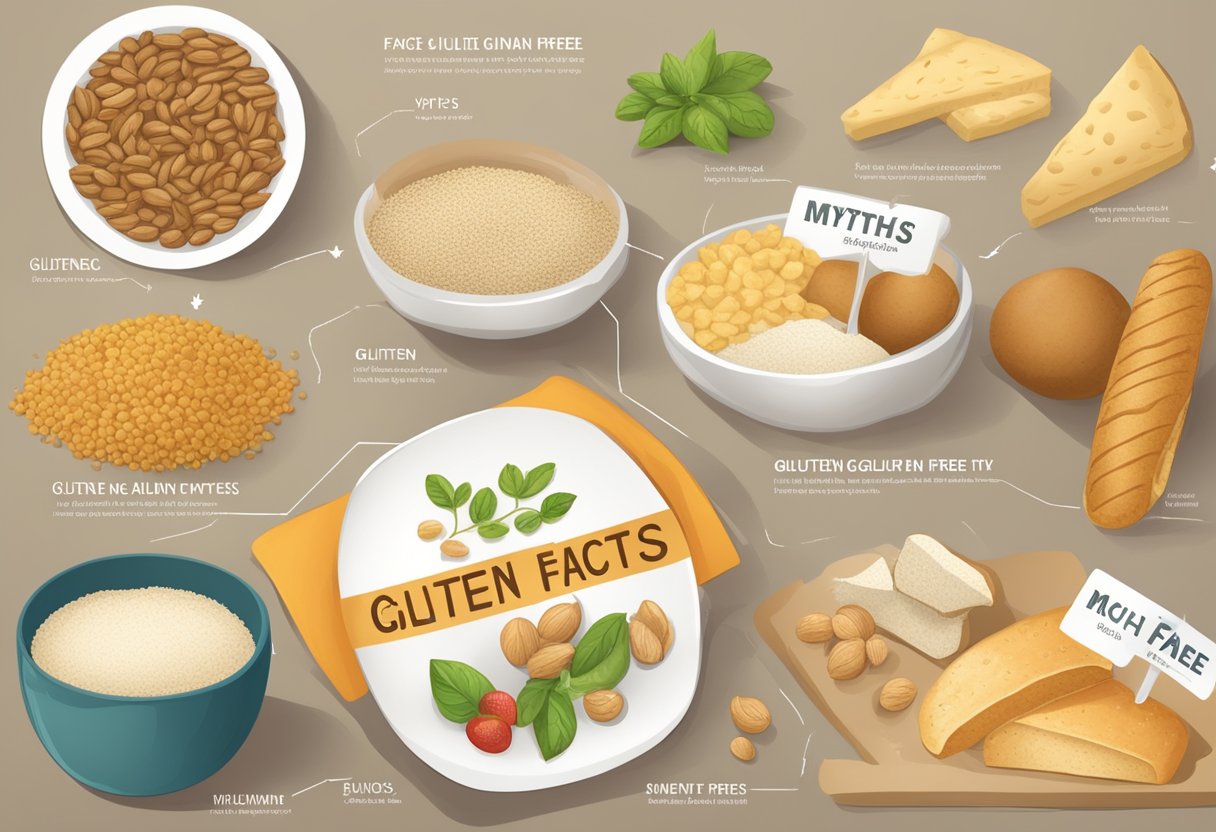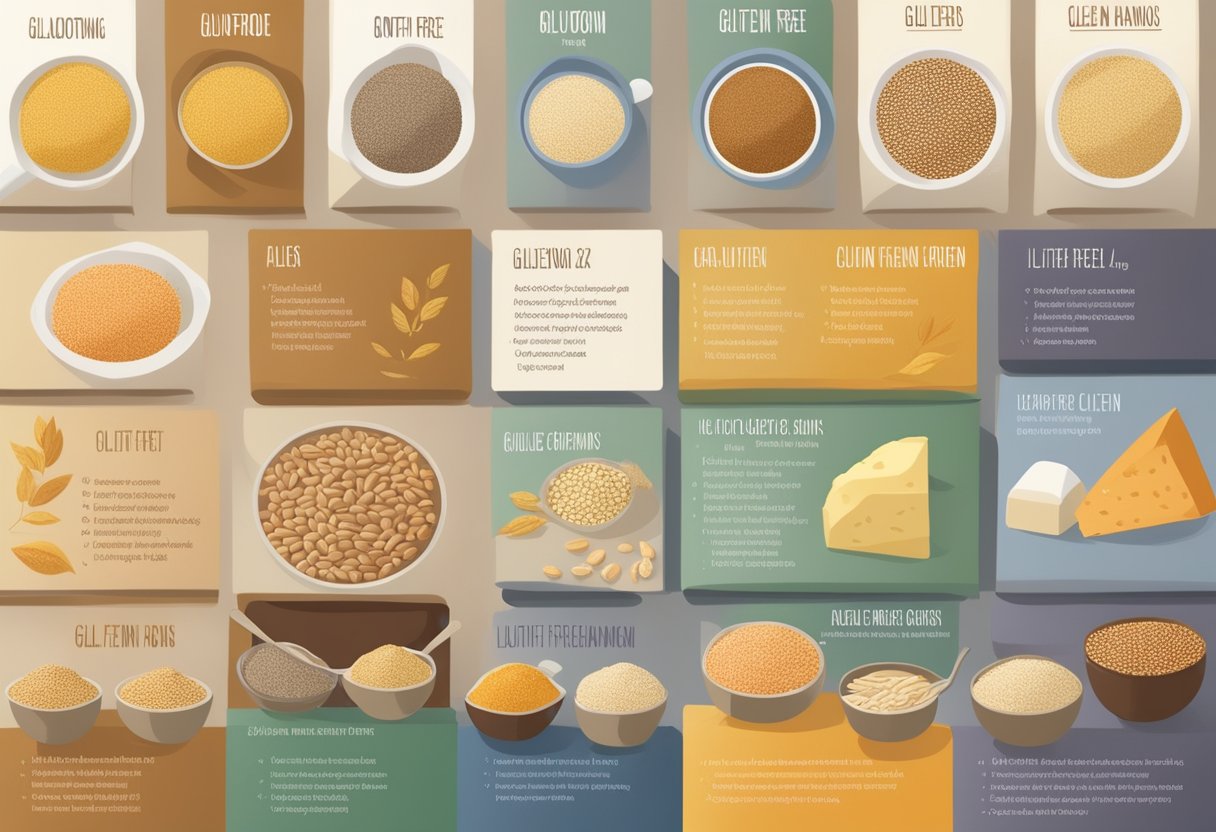In recent years, gluten-free eating has surged in popularity, often lauded for its perceived health benefits and essential for those with certain medical conditions. However, with such prevalence comes misconceptions that can distort the reality of a gluten-free lifestyle. It’s essential to distinguish between the myths and facts to make informed dietary choices and understand how gluten affects the body. Consider the rise in gluten-free alternatives and products that cater to people who opt for a diet devoid of this particular protein, often found in grains such as wheat, barley, and rye.

Living with conditions like celiac disease and non-celiac gluten sensitivity mandates a strict gluten-free diet, while for others, the choice to eliminate gluten is a lifestyle preference or part of a dietary strategy. Determining the need for a gluten-free diet should be based on accurate information and, when necessary, medical guidance to ensure nutritional adequacy and overall wellbeing. It’s also crucial to navigate the plethora of food labeling and gluten-free alternatives that have become available, empowering consumers to make choices that align with their health goals or medical requirements.
Key Takeaways
- A gluten-free lifestyle is necessary for some and elective for others, demanding discernment between health needs and dietary trends.
- Understanding gluten’s role and identifying where it’s found are vital to managing a safe and nutritious gluten-free diet.
- Reading labels and choosing gluten-free alternatives requires careful consideration to maintain dietary balance and health.
Table of Contents
Understanding Gluten and Its Sources

Before embarking on a gluten-free Mediterranean diet, it is crucial to understand what gluten is and the common sources that should be avoided or substituted.
Defining Gluten
Gluten is a protein composite primarily found in wheat, barley, and rye. It provides elasticity and a chewy texture to dough, making it an essential component in traditional bread-making and related grain products.
Sources of Gluten
The primary sources of gluten are grains including:
- Wheat: This includes all varieties such as durum, spelt, farro, and others.
- Barley: Often used in brewing, soups, and cereals.
- Rye: Typically found in rye bread, rye beer, and some cereals.
When following a gluten-free Mediterranean diet, one should focus on gluten-free grains like quinoa, rice, and corn, and incorporate a variety of naturally gluten-free Mediterranean staples such as fruits, vegetables, legumes, nuts, seeds, fish, and lean meats.
Celiac Disease and Non-Celiac Gluten Sensitivity
This section explores the distinct medical realities of celiac disease and non-celiac gluten sensitivity, including their symptoms and diagnostic methods.
Overview of Celiac Disease
Celiac disease is an autoimmune disorder where the ingestion of gluten leads to damage in the small intestine. It’s triggered in genetically predisposed individuals by the ingestion of gluten—a protein found in wheat, barley, and rye. The immune system’s abnormal response leads to inflammation and atrophy of the villi, the tiny projections lining the small intestine responsible for nutrient absorption. Symptoms can range from gastrointestinal issues to neurological problems and beyond.
Non-Celiac Gluten Sensitivity
Non-celiac gluten sensitivity (NCGS), also simply referred to as gluten sensitivity, is a condition wherein individuals experience symptoms related to gluten consumption but do not test positive for celiac disease. Symptoms of NCGS can resemble those of celiac disease but are not accompanied by the same intestinal damage. Since there is no specific test for NCGS, diagnosis often involves ruling out celiac disease and wheat allergies.
Diagnosing Gluten-Related Disorders
Blood tests and biopsies of the small intestine are standard practices for diagnosing celiac disease. Blood tests look for antibodies typically present in the blood of people with celiac disease. If test results suggest celiac disease, a biopsy of the small intestine is performed to confirm the diagnosis. Diagnosing non-celiac gluten sensitivity is more challenging, as there are no definitive tests. It often involves dietary strategies such as following a gluten-free diet to see if symptoms improve.
Benefits of a Gluten-Free Diet
Adopting a gluten-free diet can offer significant benefits, particularly for individuals with certain health conditions. Two notable advantages include the alleviation of uncomfortable symptoms and the enhancement of nutrient absorption in the body.
Alleviating Symptoms
A gluten-free diet is paramount for individuals with celiac disease, as it helps to mitigate intestinal symptoms such as abdominal pain, bloating, and diarrhea. This diet can also be beneficial for those with non-celiac gluten sensitivity (NCGS), as it often leads to a notable reduction in symptoms.
Improving Nutrient Absorption
For those affected by celiac disease, a gluten-free diet is essential for the repair of the small intestine’s lining, which is damaged by gluten exposure. Once gluten is eliminated from the diet, the small intestine can heal, thereby improving the absorption of vital nutrients, including vitamins and minerals like iron. This optimizes overall health and prevents nutrient deficiencies.
Risks and Considerations

When adopting a gluten-free diet, particularly one with a Mediterranean focus, it is important for individuals to consider the potential for nutritional deficiencies and the risks associated with self-diagnosis.
Potential Nutritional Deficiencies
Gluten-free Mediterranean diets, while offering various health benefits, may lead to certain nutritional deficiencies if not properly planned. Whole grains that contain gluten, such as wheat, barley, and rye, are commonly replaced with gluten-free grains that could be lower in fiber, B-vitamins, and iron.
- Fiber: Gluten-free grains might provide less fiber than their gluten-containing counterparts.
- Protein: Some gluten-free products may have less protein, which is essential for body repair and muscle growth.
- Fat: Gluten-free processed foods can be higher in fat to improve taste and texture.
- Nutrients: Ensuring a balanced intake of nutrients like calcium, phosphorus, and magnesium is crucial.
It’s important that those on a gluten-free Mediterranean diet include diverse foods such as fruits, vegetables, legumes, nuts, and seeds, alongside gluten-free whole grains to maintain proper nutrient levels.
Risks of Self-Diagnosis
Self-diagnosis of gluten intolerance and the subsequent adoption of a gluten-free diet without medical consultation may pose health risks. People may inadvertently neglect signs of other health issues with similar symptoms to celiac disease or non-celiac gluten sensitivity (NCGS). Misdiagnosis can lead to untreated conditions and the discontinuation of whole food groups, which might impact long-term health and the balance of nutrients.
- Celiac Disease Risks: Without a proper diagnosis, individuals with celiac disease might not receive the follow-up care and dietary guidance needed to prevent complications.
- Weight Loss Misconception: Individuals might mistakenly attribute weight loss to gluten avoidance when it could be due to other health issues or an unbalanced diet.
Individuals should consult healthcare professionals before removing gluten from their diet, ensuring that any decision is based on accurate information and that they are not overlooking potential health issues or benefits of gluten-containing foods.
Gluten-Free Foods and Alternatives
When adopting a gluten-free diet, it’s crucial to identify which foods are naturally free of gluten and understand the variety of substitutes available for common gluten-containing staples.
Naturally Gluten-Free Foods
One can find a plethora of naturally gluten-free food options that fit into a Mediterranean diet. Such options include rice, corn, soy, potatoes, beans, nuts, seeds, fruits, and vegetables, all of which are staples in a balanced, gluten-free Mediterranean diet. Whole grains such as quinoa and millet are also safe options, offering nutritional benefits and versatility in various dishes. These foods not only provide essential nutrients but also ensure variety in meal planning.
- Grains: rice, quinoa, millet
- Proteins: beans, nuts, seeds, soy
- Vegetables & Fruits: a wide variety in abundance
- Tubers: potatoes, tapioca
Gluten-Free Substitutes
For those who enjoy baked goods and pastas, selecting gluten-free products is a must. These include breads and pastas made from gluten-free flours such as rice, corn, tapioca, and potato. Oats, when specifically labeled gluten-free, can be incorporated into a gluten-free Mediterranean diet; however, they must be certified to avoid cross-contamination with gluten. In markets, one may find a range of gluten-free whole grain products that are formulated to mimic the texture and flavor of their gluten-containing counterparts, which makes maintaining a Mediterranean lifestyle more accessible.
- Bread & Pasta: Look for items made with gluten-free whole grains.
- Oats: Ensure they are labeled gluten-free to avoid contamination.
- Prepared Foods: Always check labels for gluten-free certification.
Understanding Gluten-Free Labels
Navigating the world of gluten-free labels is crucial for maintaining a gluten-free Mediterranean diet. It ensures one avoids gluten while enjoying the diet’s rich variety of fruits, vegetables, legumes, and grains like quinoa and rice.
Labeling Regulations
In the United States, the FDA’s regulation for gluten-free labeling requires that foods labeled as “gluten-free” contain less than 20 parts per million (ppm) of gluten. This standard helps individuals with celiac disease or gluten intolerance avoid foods that could trigger health issues. For a product to bear this label, it must either be inherently gluten-free or must not contain any ingredient that is:
- A gluten-containing grain (e.g., wheat, rye, barley)
- Derived from a gluten-containing grain that has not been processed to remove gluten
- Derived from a gluten-containing grain that has been processed to remove gluten, if it results in the food containing 20 or more ppm of gluten
Manufacturers must also prevent cross-contact with gluten if the product is processed in a facility that also processes gluten-containing ingredients.
Identifying Gluten-Free Products
When selecting products for a gluten-free Mediterranean diet, one must diligently examine the labels. Look for items specifically labeled as “gluten-free” or similar terms like “free of gluten,” “no gluten,” and “without gluten.” These labels indicate that the product is suitable for a gluten-free diet. However, one must also analyze the ingredients list for hidden sources of gluten. Here are typical indicators of a gluten-free product:
- Certification logos: Some products carry a gluten-free certification logo from third-party organizations, which verifies their compliance with gluten-free standards.
- Ingredient lists: Products may be labeled gluten-free, but it’s always wise to review the ingredient list for any hidden sources of gluten.
- Advisory statements: These can include warnings about potential cross-contact during processing.
For anyone following a Mediterranean diet, it’s important to seek out gluten-free grains and focus on whole foods like fruits, vegetables, nuts, seeds, and legumes, as these are naturally gluten-free and are staples of the diet. Processed products may require more careful evaluation to ensure they adhere to gluten-free guidelines.
Managing a Gluten-Free Lifestyle
Adopting a gluten-free lifestyle requires attention to detail, particularly when eating out and in preventing cross-contamination in the kitchen. Individuals must not only choose gluten-free foods but also ensure that their choices remain uncontaminated by gluten.
Dining Out Gluten-Free
When dining at restaurants, one must be vigilant to avoid gluten in various forms. Many sauces, salad dressings, and soups frequently contain gluten as a thickener or flavor enhancer. It is imperative that individuals on a gluten-free diet inquire about the ingredients used in these items. Restaurants with a focus on a Mediterranean diet may offer a variety of naturally gluten-free options such as grilled meats, seafood, and salads, but it’s important to ask about dressings and marinades.
- Ask the Server: Clearly communicate with the restaurant staff about the gluten-free diet necessities.
- Check for Certification: Look for restaurants that are certified or known for their gluten-free offerings.
- Sauces and Dressings: Always confirm whether these contain gluten, as they can often be overlooked sources.
Avoiding Gluten Cross-Contamination
Cross-contact with gluten can occur in the kitchen if proper kitchen practices are not followed. It is essential for individuals to either have a completely gluten-free kitchen or to establish strict practices to avoid cross-contamination.
- Separate Utensils: Use separate cooking utensils, cutting boards, and serving dishes for gluten-free foods.
- Gluten-Free Labels: Label containers and products that are gluten-free to avoid any mix-ups.
- Regular Testing: Some individuals may consider a visit to the doctor for regular testing to monitor their gluten sensitivity and ensure they’re not accidentally ingesting gluten.
It is everyone’s responsibility to ensure that their dietary needs are met and that the risk of accidental gluten consumption is minimized, whether it is by educating themselves about safe food options or by being proactive in discussions with restaurant staff or within their household kitchen practices.
Associated Health Conditions

Adopting a gluten-free diet is often a necessary measure for individuals with certain health conditions, particularly where gluten consumption triggers adverse effects. The necessity for this dietary change primarily stems from conditions like celiac disease and non-celiac gluten sensitivity.
Related Autoimmune Diseases
Celiac disease is an autoimmune disorder where the ingestion of gluten leads to damage in the small intestine. It is hereditary and can develop at any age. When people with celiac disease consume gluten, their body mounts an immune response that attacks the small intestine, leading to nutrient malabsorption, and it can cause long-term digestive complications. For those affected, a strict gluten-free diet is the only effective treatment.
An often underrated aspect of celiac disease is its potential association with other autoimmune conditions. Research suggests a higher prevalence of diseases such as Type 1 diabetes and autoimmune thyroid disease within the celiac population. Maintaining a gluten-free diet helps manage the symptoms and may reduce the risk of developing additional autoimmune disorders.
Other Health Issues
Individuals with gluten intolerance, also known as non-celiac gluten sensitivity (NCGS), can experience symptoms similar to those with celiac disease but without the autoimmune intestinal damage. Although less severe, it can still cause significant discomfort and health issues.
A gluten-free diet also aids in managing other health conditions where gluten may aggravate symptoms. Issues such as anemia can occur when the damaged intestinal lining of celiac sufferers leads to poor absorption of iron and other nutrients, while osteoporosis is a risk due to malabsorption of calcium and vitamin D. Ensuring a diet rich in essential nutrients while avoiding gluten can help minimize these risks.
Addressing Common Misconceptions
Unveiling the truth behind gluten-free eating helps clarify the effects on health and diet, especially as it pertains to the growing popularity of a gluten-free Mediterranean diet.
Myths About Gluten and Health
Myth: Gluten causes weight gain, and avoiding it guarantees weight loss.
Truth: Gluten itself isn’t directly linked to weight gain. In many cases, gluten-free products can contain equal or even higher calories due to added sugar or fat to improve taste, which can affect weight management.
Myth: All gluten-free foods are healthier.
Truth: Not all gluten-free products are created equal. Many processed gluten-free foods are still processed foods, which can be high in sugar and low in key nutrients.
Facts vs. Fiction in Gluten-Free Eating
Fact: For someone with celiac disease or non-celiac gluten sensitivity, a strict gluten-free diet is essential for overall health. Gluten ingestion can cause adverse reactions that damage intestinal cells, leading to health problems.
Fact: Adopting a gluten-free Mediterranean diet can deliver health benefits. This diet focuses on natural, minimally processed foods like fruits, vegetables, legumes, nuts, seeds, and olive oil, which naturally do not contain gluten and promote a balanced diet.
Frequently Asked Questions
Navigating a gluten-free lifestyle involves understanding both medical needs and nutrition. Here, common queries are addressed with clarity to assist individuals in making well-informed dietary choices.
What are the health implications of starting a gluten-free diet for non-celiac individuals?
For non-celiac individuals, the health benefits of a gluten-free diet are not clear-cut. While eliminating gluten can lead to choosing healthier, unprocessed foods, it may also result in a diet lacking in certain vitamins and fiber found in whole grains.
What are the common misconceptions surrounding gluten intolerance and sensitivity?
One widespread misconception is that gluten intolerance is the same as celiac disease. Gluten intolerance, or non-celiac gluten sensitivity, results in discomfort without the autoimmune response characteristic of celiac disease. Another is the belief that a gluten-free diet is inherently healthier, which is not necessarily true for everyone.
Are there scientifically-backed benefits to a gluten-free diet for those without celiac disease?
Scientific evidence supporting the benefits of a gluten-free diet for individuals without celiac disease is limited. Some may experience reduced inflammation and improved gastrointestinal health, but these effects are not universal.
Is it true that gluten-related health issues are less prevalent in Europe, and if so, why?
Gluten-related health issues may appear less prevalent in Europe, possibly due to differences in wheat varieties, processing methods, and overall diet composition. Europeans often follow a Mediterranean-style diet, which naturally emphasizes gluten-free foods such as olive oil, legumes, vegetables, and fish.
What are the potential nutritional drawbacks of adhering to a gluten-free diet?
A gluten-free diet can lead to deficiencies in nutrients such as iron, calcium, fiber, thiamine, riboflavin, niacin, and folate if not properly managed. Many gluten-containing grains are important sources of these nutrients.
Why might someone who does not have celiac disease choose to eat gluten-free? What are the legitimate considerations?
Individuals may choose a gluten-free diet to manage symptoms of non-celiac gluten sensitivity or to improve gastrointestinal health. They could be seeking a diet lower in processed foods, which a gluten-free diet can encourage when focusing on naturally gluten-free Mediterranean staples.



